Rip And Replace: The New IT Risk
If the term “rip and replace” is relatively new, the concept itself is far from it. Mostly, rip and replace cases happen in IT and general technology, where old and outdated systems are completely disposed of – “ripped” – and fully replaced with new ones.
This procedure does not consider add-ons or updates to existing equipment, which makes it less than optimal for some companies and users.
Due to the budget and tight control that companies enjoy having over their technology, rip and replace can be seen as a potential risk. In the majority of cases it requires a massive initial investment, which is a red flag for some and there is rarely a 100% guarantee it will pay off. There is also concern that adapting to new technology will disrupt the company’s operations and require additional resources, such as staff training and supportive IT systems.
For some businesses, the potential risk may be too great that it turns rip and replace into a threat instead of an opportunity. A significant investment in technology that proves unsuccessful could complicate a business’ everyday functions and even put them in an unstable condition for the future. The same negative result is achieved when fitting technology is adapted incorrectly or met with resistance after the replacement point.
Rip and replace is now being opposed by two IT companies: the NASDAQ listed Splunk and Dell-owned Dell EMC. They are opposing by providing a combined portfolio of purpose built solutions to avoid a procedure that, according to them, lacks “elasticity, flexibility and scalability.” Dell EMC’s data analytics leader and engineer, J. Cory Minton, says the problem is mutual between both partner and client: “If a partner sells a client something that’s good for today but three months down the road the requirements go through a massive change, they can throw all the work out the window.”
Seeing companies who are leaders in their own respective fields refuse rip and replace is worth acknowledging. Due to it being a high risk, high reward investment, not all companies are willing to adapt to it. To balance this out, it is important to see both sides and consider the pros and cons. As a company working very closely with technology and IT, we think it is important to keep up-to-date with not only the hardware and software, but also the processes and attitudes behind them.
